A History of the County of Berkshire: Volume 4. Originally published by Victoria County History, London, 1924.
This free content was digitised by double rekeying. All rights reserved.
'Parishes: Hampstead Norris', in A History of the County of Berkshire: Volume 4, (London, 1924) pp. 73-81. British History Online https://www.british-history.ac.uk/vch/berks/vol4/pp73-81 [accessed 24 April 2024]
In this section
HAMPSTEAD NORRIS
Hanstede (xi cent.); Hamsted (xii–xvi cent.); Hampstead (xiii–xx cent.); Cifrewast (xiii, xiv cent.); Ferrers (xiv, xv cent.); Norris (xvi–xx cent.).
The parish of Hampstead Norris lies on both sides of the Pang Brook, and extends somewhat to the south-west. The parish seems to have consisted of several vills, Hampstead, Eling, Wille, Bothampstead and Langley, but the bounds of these are not now known, except in the case of Langley.
The village of Hampstead lies on either side of the Pang, which here runs as a ditch beside the road. It consists mainly of red brick houses and cottages with slate and tiled roofs. A few cottages have timber framing and thatched roofs. There are hamlets at Eling, Wellhouse, Little Hungerford, Bothampstead, Langley and World's End, besides a considerable village which has grown up recently at Hermitage. There are also several isolated farms, surrounded in some cases by a few cottages, as Wyld Court, Haw Farm, Buttonshaw, Banterwick Barn and Oakhouse. The land rises from the lowest point, 270 ft. above the ordnance datum where the Pang crosses the boundary, to over 500 ft. in the northwest of the parish.
The parish contains 6,046 acres, of which more than half are arable, while the remainder are divided nearly equally between permanent grass and woods and plantations. (fn. 1) The chief crops are wheat, barley and oats. The soil is very varied. In the north and west it is chalky, often covered with a surface of clay, while in the remainder of the parish it is clay and sand, the former predominating; there are beds of plateau gravel on the high ground in the south of the parish.
The Didcot to Newbury branch of the Great Western railway, opened in April 1882, passes through the parish from north to south, with stations at Hampstead Norris and Hermitage. The Newbury and Oxford road crosses the corner of Langley township at the World's End, and the road from Newbury to Compton, known as Long Lane, runs through the parish.
The population is chiefly agricultural, but there are brick-works at Hermitage, where a number of villas have lately been erected. There is a whiting and lime manufactory at Hampstead Norris.
The common lands in Hampstead Norris were inclosed in 1771, and others in the parish some years later. No copies of these awards exist in the parish.
There are Wesleyan and Primitive Methodist chapels here.
A chapel of ease was built about 1835 at Hermitage in the south of the parish, which was called the Adelaide Chapel. (fn. 2) In 1840 Hermitage was formed into a separate ecclesiastical parish. There is a Primitive Methodist chapel here.
There was a chapel of ease at Langley in 1806, (fn. 3) but it had disappeared in 1839. (fn. 4)
Various relics (fn. 5) of the Stone Age have been found in the parish, and near Beche Wood, to the north- east of the village, there existed in 1839 two small barrows, which even then were already disappearing beneath the plough. (fn. 6) Only one now remains, and this was explored by Dr. Silas Palmer, who found in it a bronze knife-dagger. (fn. 7) Another large barrow stands to the south of the village, at the north-east corner of Park Wood. (fn. 8)
There is a large earthwork, known as Grimsbury Castle, in Fence Wood at the south of the parish, (fn. 9) and in Park Wood, just to the south of the village, is another, but in an unfinished condition. (fn. 10)
A Roman villa, near Wellhouse, was discovered about the year 1833, (fn. 11) and many Roman coins have been found in this neighbourhood. (fn. 12)
A jar of the 13th century, containing a black deposit, was dug up in the churchyard of Hampstead Norris in 1885, and is now in the Newbury Museum.
Manors
In the time of Edward the Confessor HAMPSTEAD NORRIS was held of the king by Lanc, who was succeeded after the Conquest by Theodoric the goldsmith. (fn. 13) The overlordship remained with the Crown, and in 1270 the king confirmed to the leprous women of Bradley and the brethren there a virgate of land here, the gift of Alonoth de Sifrewast. (fn. 14)
In 1166–7 William de Sifrewast was holding this manor, (fn. 15) and in 1194 Alonoth or Halenath de Sifrewast petitioned for the return of his land here, which had been seized for default in a suit against Pientia widow of William de Cauz. (fn. 16) Alonoth died in or before 1217, when his son William did homage for this manor. (fn. 17) William con- tinued to hold the manor (fn. 18) till his death before 1257, when his son Nicholas leased it for eight years to Nicholas de Chenduit and Richard de Brightwalton. (fn. 19) Soon after the expiration of this lease Nicholas in 1269–70 granted the manor in fee to Thomas de Clare, (fn. 20) after which we hear no more of this family.
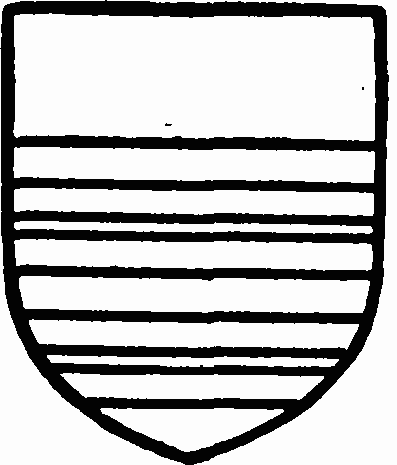
Sifrewast. Azure two gimel bars and a chief or.
Thomas de Clare had free warren here in 1275–6, (fn. 21) and in 1276 exchanged the manor with Robert de Muscegros. (fn. 22) Robert was the son of John de Muscegros and left a daughter Hawise, who married John first Lord Ferrers of Chartley, the son of Robert last Earl of Ferrers and Derby. Robert de Muscegros either had another daughter who married John son of Reginald or the latter married Robert's widow, for, with his wife, he conveyed this manor, described as Hampstead Syfrewaste, to John Ferrers and his wife in 1304–5. (fn. 23) John Ferrers died before 1315–16, when the manor was held by John de Bures, (fn. 24) who seems to have married Hawise. John de Bures died in 1350 and was succeeded by John son and heir of Robert Ferrers, kt., and grand- son of Hawise. (fn. 25)
This John appears to have been the third lord of Chartley, and in 1351–2 he obtained custody of this manor, which is stated to have belonged to Hawise Ferrers, (fn. 26) and died in April 1367 seised of this manor, held jointly with his wife Elizabeth, who survived him. (fn. 27) On her death (fn. 28) the manor followed the descent of the barony of Ferrers of Chartley (fn. 29) until William, sixth lord of Chartley, having no son, obtained licence on 14 September 1448 to sell this manor, held in chief, to the trustees of John Norreys, (fn. 30) and the sale was completed (fn. 31) not long before his death in June 1450. (fn. 32)
John Norreys had already acquired the adjoining manor of Yattendon, and Hampstead Norris subse- quently followed the same descent as the manor of Yattendon (fn. 33) (q.v.). In 1766 Norreys Bertie devised it to his cousin Peregrine Bertie, subject to an annuity to his sister Lady Elizabeth Gallini. (fn. 34) Peregrine Bertie afterwards sold the manor to the Gallinis. (fn. 35) John Andrea Gallini, the son of Lady Elizabeth, was holding Hampstead Norris in 1806, (fn. 36) but on 3 August 1834 he mortgaged it to George Eyston of Gray's Inn, who settled it upon Charles Eyston of Hendred. Charles Eyston foreclosed the mortgage on 24 November 1845, and the same day conveyed the manor to Edward Bowley, who sold it on 27 December that year to Thomas Crowther Brown and Robert Jeffreys Brown of Cirencester. These two sold the manor in 1860 to Lord Overstone, at whose death on 17 November 1883 it passed to his daughter Lady Wantage, who conveyed it in 1912 to her cousin Mr. A. K. Loyd, the present owner. (fn. 37)
In the time of Edward the Confessor Sawin held ELING of the king, and attached it to his manor of Hendred, but at the time of the Domesday Survey it was held by Roger de Ivri, who transferred it to his manor of Harwell. (fn. 38) Like all Roger's manors it became part of the honour of St. Valerie, and the- overlordship was held in the 13th century by Richard Earl of Cornwall, King of the Romans. (fn. 39) At his death it descended to his son Edward Earl of Cornwall, at whose death in 1300 it passed to the Crown. (fn. 40)
The manor was held in the 13th century of the Earl Richard by Bartholomew de Pechy or Peche, (fn. 41) who seems to have purchased it in 1246–7 of Geoffrey son of John. (fn. 42) Bartholomew was followed by his son Herbert, whose widow Lucy Peche and Bartholomew the heir of Herbert Peche had free warren here in 1275–6, (fn. 43) and in 1349 John son of this Sir Bartholomew Peche conveyed the manor to Thomas de Coleshill and others, (fn. 44) apparently in trust, on the marriage of his son John with Lady Isabel Mounbocher, daughter of Sir Richard de Wilygby. (fn. 45) In 1352–3 John Peche, jun., sold the manor to Hugh Berwyk, (fn. 46) who in 1372–3 purchased the adjoining manor of Frilsham (q.v.), after which the history of the two manors is the same until the 19th century.

Cornwall. Argent a lion gules crowned or in a border sable with bezants.
Robert Hayward, who had purchased the manors in 1800, died 21 March 1820, and by his will dated 21 August 1818 he left this manor to his distant cousins William and John Aldworth of Frilford, Berks., in equal shares as tenants in common. William and John were the sons of William and Elizabeth Aldworth and the grandsons of Robert Aldworth and Elizabeth sister of Thomas Hayward, who was grandfather of the Robert who purchased the property. The manor was sold in 1876 by William Aldworth to George Palmer of Marlston in Bucklebury, the father of the Right Hon. George William Palmer, its present possessor. (fn. 47)
The manor of WILĹE (Wille, xi cent.; la Wyle, xii, xiv cent.; Wilde, xvi cent.) has usually been identified with the estate of Well House, which lies to the south of the hamlet of Eling, but its subsequent history seems to show that it included also a long strip extending from Wyld Court Farm on the east to Bothampstead Farm on the west, lying between the manor of Hampstead Norris on the north and that of Eling on the south. (fn. 48)
In the reign of Edward the Confessor it was held of the king by Elwin, and in 1086 it was held by Gilbert de Bretville. (fn. 49) The overlordship of this passed with all Gilbert's manors to Baldwin de Redvers, seventh Earl of Devon, who was holding it in the 13th century, (fn. 50) and after his death in 1245 it seems to have passed to his widow Amice, whose second husband was Robert Gynes. It seems likely that she married for the third time Matthew de Columbers, who was overlord of this manor, (fn. 51) and was living as late as 1280. (fn. 52) At the death of Amice in 1283, as her only son Baldwin eighth Earl of Devon had died childless in 1262, the manor passed to her daughter Isabel the wife of William de Fortz Earl of Albemarle. Isabel sold to the king on 8 November 1293 the Isle of Wight, Christchurch and others estates, among which this manor was included. (fn. 53) The overlordship of this manor remained in the hands of the king until about 1330, when it was granted to Sir William Montagu, who was in 1337 created Earl of Salisbury.
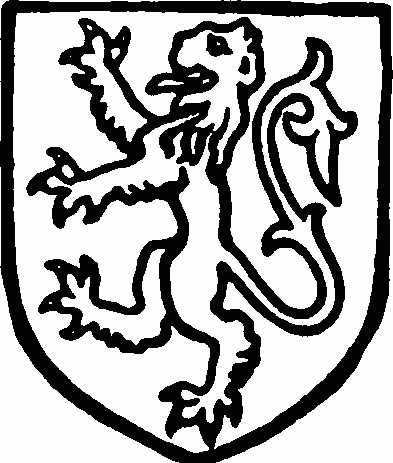
Redvers. Or a lion azure.
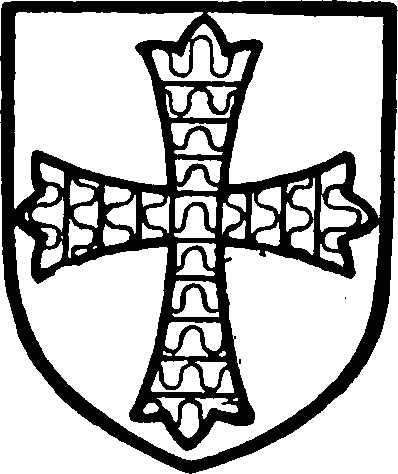
Fortz. Gules a cross paty vair.
Sir William married Katherine de Grandison, and died in 1344, when he was succeeded by his eldest son William, then aged fifteen. This William married Elizabeth daughter and heir of John Lord Mohun, and died in 1397 (fn. 54) without surviving issue, as he had killed his only son Sir William in 1382. (fn. 55) The overlordship descended to John Montagu, nephew of the last earl, being the son of his younger brother John. John Montagu, Earl of Salisbury, rebelled and was slain at Cirencester in 1400, when he was attainted and his manors came to the Crown. Although most of the estates were restored to his son Thomas in 1409, this appears to have remained with the Crown.
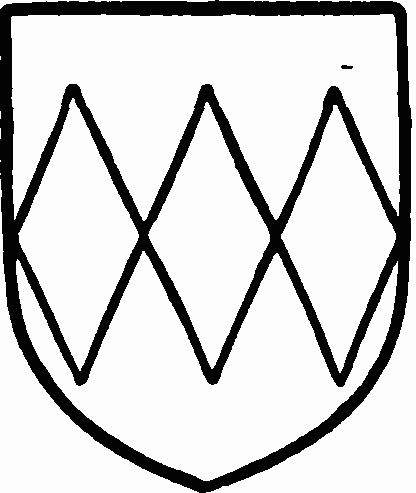
Montagu. Argent a fesse indented of three points gules.
The overlordship seems to have been divided, for in 1411 we find the manor of Bothampstead held of the Duke of Lancaster as of the honour of Tutbury, (fn. 56) while the following year certain lands at Wille are stated to have been held of Sir Robert Ferrers, lord of Chartley, as of his manor of Hampstead. (fn. 57)
As in the case of Peasemore (q.v.), the overlordship of the Bothampstead portion was held of the Earls of Salisbury by Sir Richard Abberbury in 1390. (fn. 58)
William held this manor of Gilbert de Bretville in 1086, (fn. 59) and in 1199 Robert de la Wille sold a virgate of land here to William son of Hereward. (fn. 60) Walter de la Wille was holding the manor in the 13th century, (fn. 61) and William de la Wille held it in 1397, after which we hear nothing further of this manor. (fn. 62)
Early in the 14th century lands in Le Wyk (fn. 63) and Bokhampstede were held by William de Wantage, and after his death by his widow Joan, and in 1311 these lands were in the king's hands by reason of the minority of their son John. (fn. 64)
Immediately after this we find that certain lands at La Wille were in the hands of Elias de Coleshill, who received a grant of free warren in all his lands here, as well as those in Hampstead, Basildon and Ashampstead, in 1311. (fn. 65) He was holding these lands in 1316, (fn. 66) and at his death they descended to Thomas de Coleshill, apparently his son. Thomas is described as of La Wille in 1350, when he acknowledged himself to be in debt to Thomas de Stapelford. (fn. 67) His affairs seem to have become more involved, for in 1352 he assigned a yearly rent of 20 marks, arising out of his lands here and at Buckhold, to Richard de Causton, citizen and mercer of London. (fn. 68) In 1355 this rent was purchased by Isabel widow of Sir John de Brumton, and the following Easter the property was conveyed to William Cokeswell and William Ceresy in trust for Isabel for her life, with reversion to Thomas de Coleshill, his wife Lucy, and afterwards in succession to their sons Richard and Thomas and their daughter Isabel. (fn. 69)
Isabel de Brumton appears to have outlived Thomas and Lucy as well as their two sons, both of whom died without issue, and the property passed to Isabel daughter of Thomas de Coleshill. The latter seems to have married firstly — Inkepenne and secondly Hugh Crane. At her death in 1410 the property passed to her grandson Richard Inkepenne, the son of her son Robert. Richard was about twenty-one years of age at the time of his grandmother's death, (fn. 70) and was holding the manor in 1428, (fn. 71) and it is possible that this estate is represented in part by the messuage and 50 acres of land in Wil(de) held in 1517 by the Prioress of the Minoresses. (fn. 72)
It is also probable that the estate just described is the same as Well House, which is again mentioned in 1610, when John Dancastle died seised of a capital messuage here with 300 acres of land which was held of John Norreys as of his manor of Hampstead Norris. The estate descended to his grandson John, the son and heir of his son John, who was then aged twelve and a half years. (fn. 73) This John, who married Anne Fettiplace, was in 1634–5 a recusant, and the estate, then in the tenure of his uncle Griffin Dancastle, was forfeited and granted by the king to Thomas Hayward. (fn. 74) The subsequent history is obscure, but the estate is now the property of the Right Hon. George William Palmer.
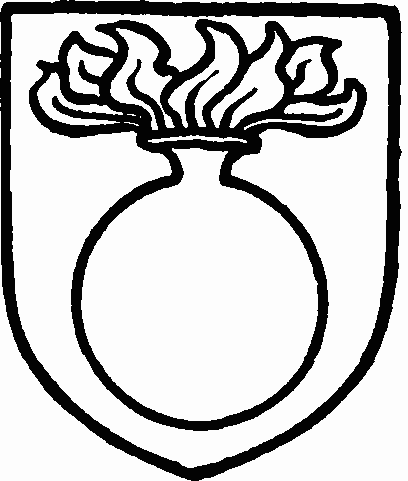
Dancastle. Azure a fire ball or aflame.
Other lands known as the manor of BOTHAMPSTEAD (Bokhampstede, Bodenhamsted, xiv cent.; Botenhampstead, xiv and xv cent.; Bottomstead, xvi cent.; Botthamstead, Bottam Hampstead, Bottom, xvi and xvii cent.) passed before 1316 into the hands of John de la Beche, who had a grant of free warren here on 10 May in that year, (fn. 75) which was confirmed on 16 August in the following year. (fn. 76) He held these lands jointly with his wife Isabel, but his lands were for a time taken into the king's hands in 13 23–4. (fn. 77) They seem, however, to have been restored to him, for he died in 1328 seised of a capital messuage and land here held of the lord of Peasemore, being followed by his son Thomas, then aged fifteen. (fn. 78)
This land passed with the manor of Bradfield (q.v.), and Edward Langford died seised of it in 1474, (fn. 79) leaving it by will to William, his younger son, with reversion respectively to John and Edward, sons of his elder son Thomas. (fn. 80) Thomas died seised in 1493, leaving a son John, (fn. 81) whose daughter Anne married William Stafford. William and Anne apparently sold the manor to Sir Richard Nevill Lord Latimer in 1522. (fn. 82) It was conveyed in 1560 by Sir John Nevill Lord Latimer and John Stampe to John Gwyn, apparently in trust. (fn. 83) At Lord Latimer's death in 1577 his estates were divided among his four daughters, this manor passing to his eldest daughter Catherine widow of Sir Henry Percy, eighth Earl of Nor:humberland. (fn. 84) In 1586 she settled it, under the title of the manors of 'Bottamhampstead' and Hampstead Norris, on her marriage with Francis Fyton, (fn. 85) and this conveyance was confirmed by a patent in which the manors are called 'Botthamsted' and Hampstead Norris. (fn. 86) In 1592 she and her second husband conveyed this estate to fresh trustees, (fn. 87) and she died on 28 October 1597 seised of the property, which passed to her husband for life, with remainder to her son Henry ninth Earl of Northumberland. (fn. 88)
This estate seems to have been sold to Sir Peter Vanlore, who died on 6 September 1628 seised of the manor and lordship of Bottom and the manor of Hampstead Norris. (fn. 89) It was then divided among his heirs, as was his manor of Speen (q.v.), and many references to transactions by these heirs have been found relating to the manor of Bottom and Hampstead Norris until 1667, after which the descent is difficult to trace. During the 18th century, however, the manor appears to have come into the possession of the Berties, and belonged in 1806 to John Andrea Gallini. (fn. 90) It afterwards followed the descent of Hampstead Norris, (fn. 91) passing to the Eystons, Bowleys and Browns, and so to Lord Overstone and his daughter Lady Wantage, who conveyed it to her cousin Mr. A. K. Loyd, the present owner, in 1912.
The manor of LANGLEY, together with the manor of Bradley in the parish of Chieveley, seems to be the unnamed estate in the hundred of 'Roeberg' held in the time of the Confessor by Tunna and at the time of the Domesday Survey by Gilbert de Gand or Gaunt. (fn. 92) Gilbert, who was a son of Baldwin Count of Flanders, came over to England with the Conqueror, married Alice de Montfort, and died during the reign of William Rufus, leaving two sons, the elder of whom married Maud daughter of Stephen Earl of Britanny. Their elder son Gilbert married Roesia Countess of Lincoln, became Earl of Lincoln in her right, and left an only daughter Alice, who married Simon de Liz Earl of Huntingdon and Northampton, and died without legitimate issue. Her heir was her uncle, Robert de Gand, who died in 1162, leaving a son Gilbert, surnamed the Good, whose son Gilbert was taken prisoner at Kenilworth, was disinherited for treason, but redeemed his lands for £3,000 in the time of Edward I. (fn. 93) He or his father, who died in 1241, was returned as holding the overlordship of these manors in the 13th century, (fn. 94) and the younger Gilbert died in 1274, when the overlordship passed to his son Gilbert, who married Laura sister of Alexander Baliol. At his death in 1297 he left two daughters, and as he had no son he bequeathed most of his estates, including the overlordship of these manors, to the king. (fn. 95)
Robert held this manor of Gilbert at the time of the Domesday Survey, (fn. 96) and in the 13th century the manor of Langley was held by Gilbert de Sanford of Great Hormead, chamberlain to Queen Eleanor. (fn. 97) He married Laura, and died in 1250, leaving an only daughter Alice, married to Robert de Vere, afterwards fifth Earl of Oxford. Robert was only ten years of age at the time of the death of his father-inlaw, and succeeded his father, Hugh de Vere, the fourth earl, in 1263. He seems to have granted this manor to his second son Hugh, who was created Lord Vere, and obtained a grant of free warren here in 1290. (fn. 98) Robert died in 1296, and, though his widow survived him until 1317, (fn. 99) and Hugh seems to have lived until the following year, the eldest son Robert seems to have inherited this manor at once, for he is returned as holding it in 1315–16. (fn. 100) In 1330 he had licence to enfeoff Robert de Cheddeworth and William de Parco with the manors of Langley and Bradley, held in chief, in trust for himself and, if he died without issue, for his nephew John (fn. 101); at the same time he received a fresh grant of free warren in Langley. (fn. 102) He married Margaret daughter of Edmund Lord Mortimer and died without issue in 1331, when the manor and title passed to John the son of his brother Sir Alphonso de Vere, then aged nineteen. (fn. 103)
John de Vere, seventh Earl of Oxford, did homage for his lands without delay and received possession of these in May the same year. (fn. 104) The manor then followed the descent of the earldom of Oxford (fn. 105) until the death of Robert de Vere, ninth Earl of Oxford, in 1392, when the king claimed the reversion. (fn. 106)
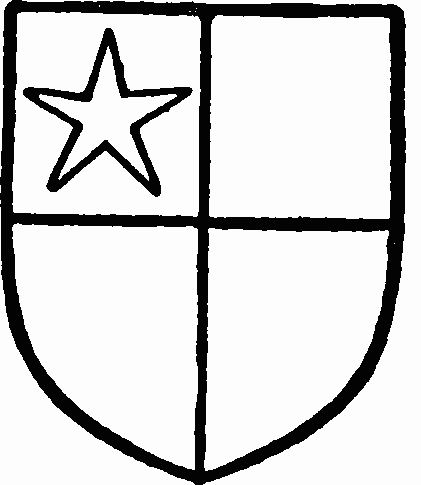
Vere. Quarterly gules and or with a molet argent in the quarter.
Nevertheless the manor apparently passed the same year to Robert's uncle, Aubrey de Vere, who was created Earl of Oxford, the first of the new creations, and in spite of the exercise of certain rights claimed by the Crown seems to have followed the descent of the earldom of Oxford till the forfeiture of the estates of John Earl of Oxford, the third or twelfth earl, in 1461–2. In 1471 the forfeited estates were granted by King Edward IV to his brother Richard Duke of Gloucester, (fn. 107) who became King Richard III.
When the manor came into the king's hands in 1461–2 it seems likely that some or all of the lands were sold to Alice widow of William Duke of Suffolk, who was holding the manor of Donnington and other lands adjoining, besides some of the land in Bradley. (fn. 108) No record of such a grant has been found, but in 1476–7 we find that she had bequeathed by will at her death in 1475 the manor of Langley to her son John Duke of Suffolk. (fn. 109) At John's death in 1491 it must have passed to his son Edmund, who was attainted in 1503, when his lands were forfeited, and in an inquisition held in 1510 he is said to have held the manors of Langley, West Bradley and others. (fn. 110)
After the forfeiture of the Duke of Suffolk the manor was in 1510 granted by King Henry VIII to the Lady Anne, daughter of King Edward IV and wife of Thomas Howard, (fn. 111) afterwards Duke of Norfolk, who as Thomas Earl of Surrey and Lord High Admiral sold it 5 December 1515 to Charles Brandon Duke of Suffolk. (fn. 112) By an Act of Parliament in 1535–6 an exchange of lands was authorized between the duke and the king by which this manor came once more into the hands of the king. (fn. 113) For some time it remained attached to the royal manor of Donnington, (fn. 114) until in March 1545 it was sold to Edward Fettiplace, the king's servant. (fn. 115)
Edward Fettiplace died without issue and his widow Anne married Richard More of Burghfield, who was holding the manor in 1569, (fn. 116) conveyed it in 1570 to Francis More and William Prentyce, apparently in trust, (fn. 117) and sold it the same year to John Smith, (fn. 118) after obtaining licence to alienate the manor. (fn. 119) John Smith died seised of the capital messuage here in 1629–30. (fn. 120)
For a time the history of the manor is obscure, but by the middle of the century it seems to have passed to Thomas Head. This Thomas appears to have been a son of Adam Head of Chilton by Alice his wife, and to be the Thomas Head of Langley whose name appears as surveyor of the highways in the churchwardens' account book of this parish. The name occurs also in 1659, 1670 and 1675, (fn. 121) and it is recorded that a tombstone buried in the church at the time of its restoration bore the inscription 'Sir Thomas Head ob. 1683. (fn. 122) His wife's name was Mary, and he left a son Peregrine, born in 1645, but the latter appears to have died without issue, as the estate passed to John Head, son of John Head of Chilton, the elder brother of Thomas.
John Head of Langley married in 1687 Anne daughter of Richard Pocock of Chieveley and Sarah his wife, and died in 1711, when he was succeeded by his eldest son Richard. Richard Head married Elizabeth daughter of Dr. John Wallis, and died in 1739 or 1740, when he was succeeded by his eldest son Thomas. He was knighted in 1744 and in 1750 married Jane daughter of Rowland Holt of Redgrave, Suffolk. (fn. 123) He was buried at Hampstead Norris in 1779, when, as his elder son William had died unmarried the previous year, he was succeeded by his younger son Walter James, who in 1769 took the name of James on inheriting the Denford estate from John James, who had married his great-aunt Elizabeth Head. (fn. 124)
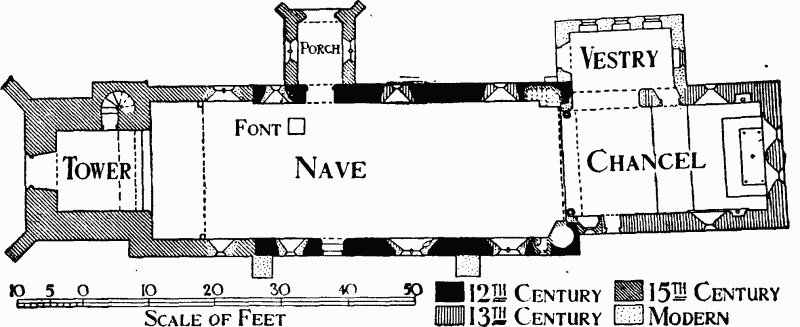
Plan Of Hampstead Norris Church
Walter James Head James was created a baronet in 1791 and died on 8 October 1829. He was holding the manor in 1806, (fn. 125) but the estate was sold either by him or his heirs to John Thomas Wasey, who was holding it in 1839. (fn. 126) On his death the estate passed to his daughters Mrs. Jane Stackpool and Miss Mary Wasey, who sold it to Mr. Lewis Loyd, from whom it passed to his son Lord Overstone, whose daughter, Lady Wantage, afterwards held it.
Churches
The church of ST. MARY THE VIRGIN consists of a chancel 28 ft. by 16 ft. 2 in., north vestry, organ chamber, nave 61 ft. 7 in. by 20 ft. 6 in., west tower 12 ft. square, and north porch. These measurements are all internal.
The walls of the eastern part of the nave are probably of the 12th century, but the only details remaining of this date are the north and south doorways, which date from about 1170. The building then probably consisted of a small chancel and a nave of the same width as the present one but shorter. In the 13th century the chancel was rebuilt and new windows were inserted in the nave. The tower is of 15th-century date, and it is probable that the nave was lengthened westwards when the tower was built, the break in the north wall indicating its original extent. The north porch is also of this period. In the year 1880 the church was restored, the vestry and chancel arch, the restoration of windows and the plastering of the walls being of this date.
The chancel has two 13th-century lancet windows in the east wall, rebated externally and having continuously moulded angles of chalk to the inside splays. In the north wall is a plain lancet much restored. To the west of this are the modern doorway to the vestry and the archway for the organ. Near the east end of the north wall is an aumbry with rebated jambs, a central mullion and a square head. In the south wall are two single lights, the easternmost like the opposite lancet and the western mostly modern, though the original seems to have been of 15th-century date. Between these is a 13th-century priest's doorway, the pointed head only being original. Near the east end of this wall is a trefoil-headed pillar piscina with a very small basin. The sill of the first window of this wall is brought very low to serve as a sedile. The modern chancel arch is of two orders, and has detached octagonal jamb shafts with moulded bases and foliated capitals of 13th-century design.
Of the four windows in the north wall of the nave the two easternmost are 13th-century lancets partly restored, the first being larger than the second and having a chalk head. The third and fourth windows are modern, and of one and two lights respectively. At the east end of the wall are the stairs to the former rood-loft, which start at a considerable height above the floor level. The arch and vault over the first few steps are modern, but the western jamb of the upper doorway survives. The north doorway, which is between the second and third windows, is of 12th-century date with chamfered jambs and a semicircular arch and has a moulded abacus and a double billet moulded label. Near its west jamb is a deep aumbry with rebated jambs and a bolt-hole. This was probably used for the chrism oil at the font, as it is close to the original west wall. At the south-east is a splayed projection which probably contains another rood stair, but is now blocked. A little to the west of this, high up in the wall, is a small 15th-century trefoiled ogee light with a square head inserted to light the rood-loft. Lower down is a small much damaged piscina. Above and immediately adjoining this is a modern window of two lights; the next window to the westward is of a similar number of lights and the tracery is almost entirely modern, but in the east internal splay is a niche for a figure with a trefoil head and a moulded corbel. To the west of this again is the 12th-century south doorway, which is now blocked. The jambs and semicircular arch are chamfered, and there is a moulded impost. The roll label moulding is nearly all modern.
The tower arch is two-centred, and of one chamfered order with a rough label on the east face, resting on a modern abacus. In the west wall of the ground stage is a late 15th-century doorway with moulded jambs and fourcentred arch under a square head with shields in the spandrels and a moulded label. Above it is a three-light window of the same date with tracery in a two-centred head having a moulded label with shield-stops. Externally the tower is of two stages with a modern embattled parapet and western angle buttresses extending to about half the height of the second stage. On the west and south, a little below the stringcourse which divides the stages, are small windows with pointed heads. In the north face of the bell-chamber is a window of two trefoiled lights under a four-centred head continuously moulded with the jambs. The west and south windows are also of two lights but have two-centred heads and plainer jambs. The east face has a single light of the same design. There is a rectangular stair turret on the north reaching to the first stage only. The 15th-century north porch has a window in each side wall of two trefoiled lights under a square head. The twocentred north entrance is of two continuous chamfered orders.
The walls of the tower are of plastered flint with stone dressings. The nave and chancel walls are covered with flint chip plaster leaving the stone quoins exposed. The vestry, the south buttresses and the east gable of the nave are of modern flint and stone. The roofs are tiled. The western part of the nave roof rises a little higher at the ridge than the rest. The chancel has an early 15th-century timber roof with curved supports to the collars and curved wind braces. The nave roof, which is plastered, has arched braces with moulded pendants and is dated 1635. The western part is wholly plastered.
The font now used is modern. Beside it is a small marble font on a fluted shaft which was given by Mr. Benj. Mathews in 1768. The one in use before that date is now at Stone Church, Bucks.
The north door is of old timber and has old plain iron hinges. There are six old pews, two in the porch and four in the tower. The west gallery is modern.
Near the east jamb of the north-western window Hampstead Norris Church from the North-west. of the nave is a small stone cross which was found buried in the plaster. It is carved in relief and has a kind of moulding at the terminations and a small cross paty in the centre. At the base is what looks like the commencement of a shaft. Fixed against the blocked south doorway of the nave in a glass case is a broken slab of stone on which is carved in low relief a mounted knight in armour with lance and shield, apparently of the early 13th century. It was found at the restoration of the church, face downwards, having been used as a step to the priest's doorway.
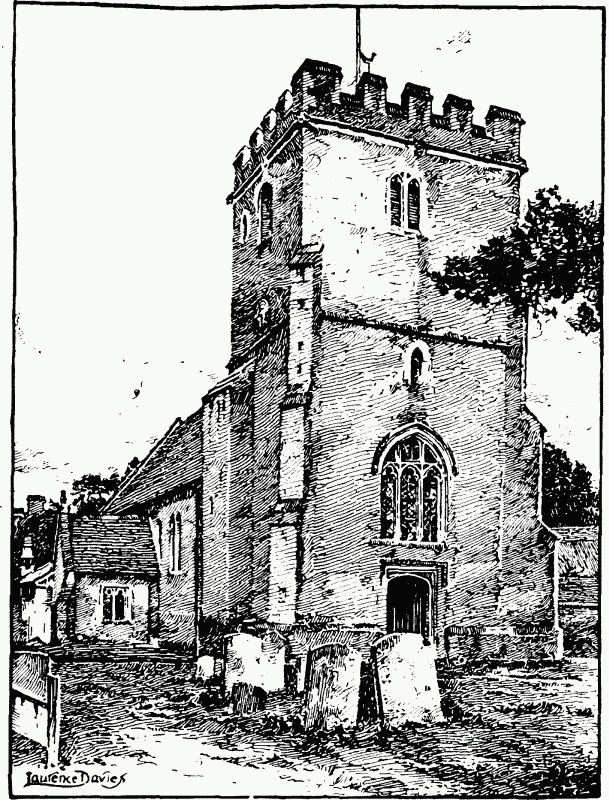
Hampstead Norris Church From The North-West.
To the east of this is a 13th-century painting of our Lady now preserved under a panel. This with many other paintings was found at the restoration under the whitewash and is the only one left. At the same time foundations and other portions of a stone rood-loft were discovered. Near a gate on the northern side of the churchyard is the moulded octagonal base of a calvary with the stump of the cross let into it. Each side has quatrefoil panels in which are shields and four-leaf ornaments alternately.
There are six bells, the first having the inscription 'Samuel Knight made mee the leder of this ring to bee' and the date 1703; the second is inscribed 'Henri Knight made mee 1619'; the third has the words 'Honor God 1637'; the fourth has 'Samuell Knight made me 1674'(the top part of the 6 is missing, which makes the date read 1074); on the fifth bell is 'Fear God. Honour the King. TS. CD. CW. SK. 1685,' the last two letters being the initials of Samuel Knight; the tenor has only the date 1675. On the roof of the tower is a small clock bell cast by John Warner, 1885. The weathercock on the cote over this bell is dated 1691.
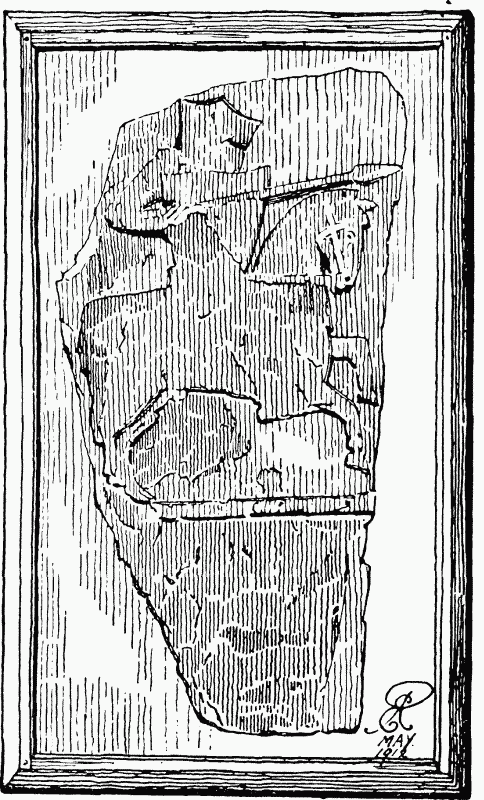
Carved Stone, Hampstead Norris Church
The communion plate consists of a cup, paten and flagon of plated ware given in 1804.
There are five books of registers previous to 1812, the first being of paper in good condition, containing entries from 1538 to 1626, but with several small gaps; the second book is of parchment and contains all entries from 1626 to 1753 and some 17th-century briefs; the third has baptisms and burials from 1753 to 1812 and marriages for 1753 and part of 1754; the fourth continues the marriages from 1754 to 1789, not on printed forms, and the fifth the same from 1790 to 1813.
The church of HOLY TRINITY, Hermitage, built in 1835, is of brick, and consists of chancel, nave, south porch and western bell-turret. The living is a vicarage in the gift of the Marquess of Downshire.
Advowson
There was a church here at the time of the Domesday Survey, and the prebendary serving it held half a hide of land in free alms as the endowment of the church. (fn. 127) The church was valued in 1291 at £7 6s. 8d. (fn. 128) The rectory and advowson came into the hands of the priory of Goring, and at the Dissolution in 1537 it was valued at £14, while the pension received from the vicar was said to be 3s. (fn. 129) In 1538 all the estates here of the priory of Goring were granted to Charles Brandon, Duke of Suffolk, (fn. 130) but returned to the king, in all probability with the manor of Langley (q.v.), and were by him granted in 1544 to Henry Norreys, the king's servant, and Margery his wife, who were holding the manor of Hampstead Norris. (fn. 131)
The advowson descended in the Norreys family until 1622–3, when Thomas Earl of Berkshire and Bridget his wife sold the rectory and advowson to Sir Peter Vanlore, (fn. 132) who presented in 1629, (fn. 133) and this property passed to his children in the same way as his manor in the parish of Speen (q.v.), and eventually came into the hands of Constantine Skynner, who presented in 1666. (fn. 134) The advowson was subdivided like the rest of the property. Some of the shares were conveyed in 1674 by Nathaniel Knight, Alexander and Letitia Blagrave and Bemon and Naomi Needler to Edward Byde and Thomas Waster, while in 1676 the heirs of Peter Vanlore the younger conveyed theirs to Daniel Blagrave and Joseph Baker. (fn. 135)
It would seem probable that eventually the whole estate came into the hands of the heirs of Mary the third daughter of Sir Peter Vanlore the younger. Mary married Henry Alexander third Earl of Stirling, and her son Henry, the fourth earl, married Judith daughter of Robert Lee of Binfield and died in 1690. It was probably Judith's brother Robert Lee who presented in 1748 and 1753. Judith's daughter of the same name married Sir William Trumbull of Easthampstead Park, and their son William married Mary daughter of Montague Lord Blundell, and left an only daughter Mary. This Mary married the Hon. Martin Sandys, fourth son of Samuel Lord Sandys, and Edwin Blundell Sandys presented in 1782. Martin's daughter Mary eventually inherited the barony of Sandys, and carried the rectory and advowson to her husband Arthur Hill, second Marquess of Downshire, who placed them in settlement in 1787. (fn. 136) The patronage was sold by the fifth marquess in 1871 to Luke Lowsley, who died in 1892, leaving it to his eldest son Mr. Lionel Dewe Lowsley, the present patron. (fn. 137)
Charities
Parish of Hampstead Norris.—Charity of William Emery, founded by will 1690. The trust fund arising from the sale in 1902 of the trust estate consists of £333 6s. 8d. Newport (Mon.) Corporation 3 per cent. stock, held by the official trustees. The annual income is expended in pursuance of the trusts in the purchase of five white fustian greatcoats for shepherds or labourers and the balance is distributed in sums of 2s. 6d. or 3s. among indigent widows.
In 1811 Ann Cowslad, with the view of carrying into effect the testamentary intentions of James Wigley, which were void in mortmain, by deed settled 3 r. 11 p. with two cottages situate in Little Hungerford in this parish, on trust that the rents and profits thereof should be distributed annually among the poor inhabitants in money, clothes, food or fuel. The net income of about £9 a year is expended in blue serge for petticoats, which is distributed among widows and poor women with large families.
In 1843 the Rev. James Reed, a former vicar, by will proved in the P.C.C. 25 February, bequeathed £100 in trust to be invested and the interest applied in the purchase of a substantial greatcoat to be given to a labourer who should have served ten successive years on the same farm. The legacy was invested in £101 16s. 9d. consols, producing £2 10s. 8d. a year.
Ecclesiastical district of Hermitage.—The official trustees hold a sum of £29 16s. 3d. local loans 3 per cent. stock, representing an abated legacy of £100 by will of John Pargiter, proved at Oxford 19 September 1888.
Also £74 18s. 1d. like stock representing a legacy of £75 bequeathed by the will of the Rev. Philip Alexander Longmore, proved at London 28 February 1902.
The income of the former charity is paid into the funds of the Hermitage Provident Club, from which gifts of coal, blankets and flannel vests are made annually at Christmas.
The income of the second charity mentioned, amounting yearly to £2 4s. 8d., is distributed at Christmas in beef and doles.
